Disney Lorcana Rules & Getting Started Guide: How to Play
Lost the rules, need a refresher or simply looking for some quick direction on how to play Disney Lorcana? Look no further.
Disney Lorcana has, without a doubt, shaken up the CCG community by bringing Disney’s gargantuan back catalogue of cartoons, films and TV-shows to a new format. If you’ve ever wondered about Mickey Mouse’s odds against The Lion King’s Scar, then you don’t need to wonder any longer.
Joining the ranks of the likes of Yu-Gi-Oh, Magic: The Gathering and The Pokemon Trading Card Game, Lorcana will seem familiar to a lot of people who have picked it up, however, there are some fundamental differences, and you’ll need to learn to play if you intend to do anything beyond collecting.
Below we’ll go through how to win the game, how to read the information on the cards, touch on deck rules and then go through setting up for and then the order of play for a match.
Navigation: Winning in Lorcana | Lorcana Cards Layout Explained | Everything You Need to Know About Lorcana Decks | Lorcana Match Set-Up | Lorcana Rules: Refresher Version | Lorcana Rules: In-Depth Version
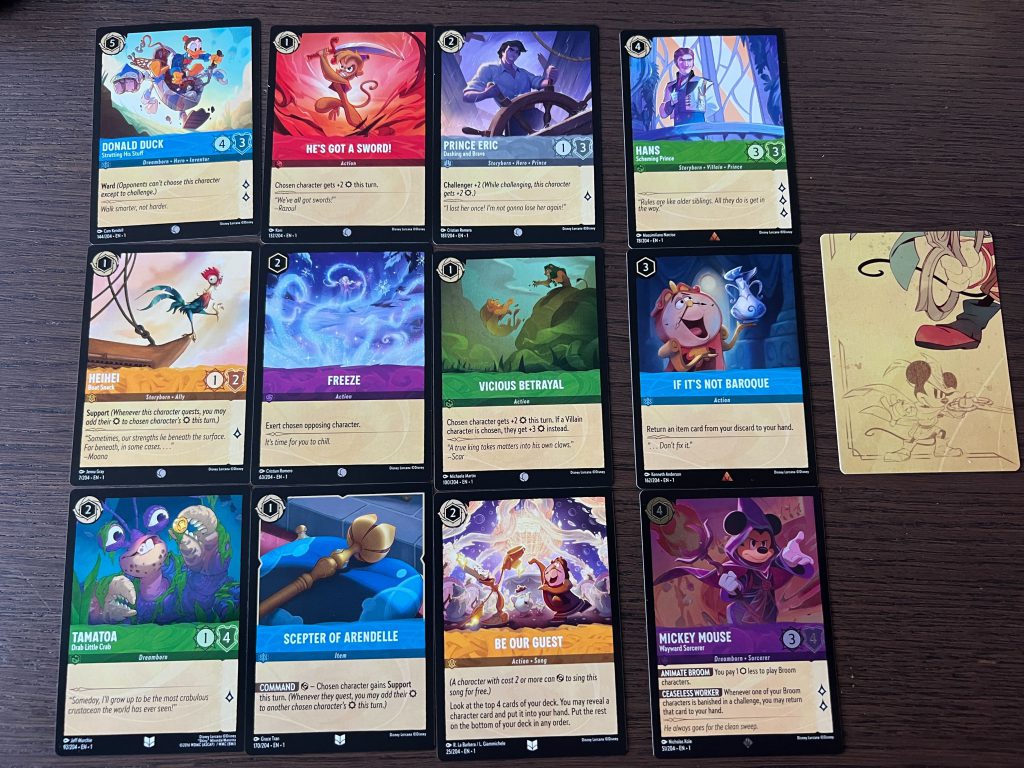
Winning in Lorcana
As an Illumineer your job is to gather lore by summoning up Disney characters, items and songs — known as glimmers. The twist, however, is that much like other CCGs, you’ll need a resource in order to bring those glimmers into play. in this case, that’s ink.
You’ll sacrifice cards from your hand that have a ring around their cost (top-left) in order to add them to your ink pool. This then serves as a currency used to bring cards into play, however, there are plenty of other effects from cards that will allow you to add to your ink well, bring in characters and songs and — perhaps, for you, more importantly — banished the summoned creatures of your rivals.
There is an additional way to win — however, it’s very uncommon — and that is to have your rivals be unable to draw another card at any point. There are some strategies which can encourage a player to fall into the trap, for instance by banishing their glimmers when they are running an ink-heavy sapphire deck.

Navigation: Winning in Lorcana | Lorcana Cards Layout Explained | Everything You Need to Know About Lorcana Decks | Lorcana Match Set-Up | Lorcana Rules: Refresher Version | Lorcana Rules: In-Depth Version
Lorcana Cards Layout Explained
While there are various cards in Disney Lorcana, ranging from characters to songs, all of the cards feature mostly the same elements. The exception to this is that character cards feature three extra types of iconography, which we’ll explain after we’ve gone over the shared features.
On Every Card
Every card will have one of the six ink colours. Yellow is Amber, Green is Emerald, Blue is Sapphire, Purple Amythyst, Red Ruby and Silver is Steel. At present, there are no cards which specifically affect cards based on their ink colour, however, only have one or two of the ink colours in your playing deck, so it is important to pay attention while formulating future strategies. The ink symbol is just below the classification or name, but most importantly, the character’s name is always present over a bar of the ink colour.
Cost: This is a number in the top left corner of the card. It’s the number of ink that needs to be used (effects/abilities aside) to summon the glimmer into play. If it is surrounded by a golden ring then the card can instead be turned into ink in the inkwell; a core part of gameplay that replaces playing resources in other CCGs.
Name: While it might seem a little obvious, each card has a name. Notably, many of the character cards also feature a version name (for instance Spirit of Wonder, for Elsa, or Shapeshifter, for Merlin) which does differentiate them from one another. Lorcana features a Shift mechanic which allows you to pay a reduced price to replace the card facing with another of the same character, which is a cost-effective way of swapping out versions mid-game.

Classifications: Most cards will have at least one classification, these are a way that Lorcana cards are grouped and that they can play well with one another. For instance, Mickey Mouse Wayward Sorcerer has the ability to ‘Animate Broom’ which means that any card with the Broom classification costs 1 less ink than before. Building decks around abilities that operate on classifications is advanced play for most, but if you carefully use the fact that a deck can feature a card up to four times, you could be onto something special
Abilities and Effects: While some cards will simply feature a blurb and image, most of them will have some sort of ability or effect on them. These are features of the card that give you extra things you can do with them, or change the rules of the game in some capacity. These will always detail how and when you use them, although it should be noted that many abilities for lower level characters will often exert the card which is symbolised with a small icon indicating a turning arrow.
Blurb & Image: Each Lorcana card contains an image, indeed, for many it’s the real draw of the game. However, not every card includes a blurb; those are largely reserved for cards that don’t have abilities or effects, or had a little room left over underneath those that did. At the foot of the card you’ve also got the trademark notice, a card count, the artist name and the card rarity.
Rarity: At the bottom of the card, in the centre, there’s a rarity symbol. There are five different rarity symbols, but there are also two extra conditions to the card which are worth noting. In rarity they are the silver circle, meaning Common, the tall, white chevron means Uncommon, the bronze triangle means Rare, the silver square means Super Rare, and the gold pentagon means Legendary.
The addition two rarity indicators are a full borderless card, which is called an Enchanted card. There were six of these available for the first chapter of Lorcana and they’re incredibly uncommon. They also feature a hollowed, rainbow hexagon in their footer. Finally, there are Foil versions of each and, whether it can be counted as a rarity or not (as it doesn’t originate from booster/starter packs) there are also Promo cards from events.
On Character Cards
Character cards feature a couple of extra card elements, which relate to when they challenge other cards, and when they quest for lore.
Strength: Surrounded by a star shape and situated on the right hand side of the card, strength is the amount of damage that a character deals when they challenge another character
Willpower: Next to the strength stat is willpower, surrounded by a shield shape. This is the amount of damage it takes to banish this character from play. As damage stacks, you’ll likely need a damage token to track the changes to this stat for your stronger characters
Lore Value: Finally, the weighted diamond shapes (from the O in Lorcana) symbolise the number of lore you gain from setting your character to quest.
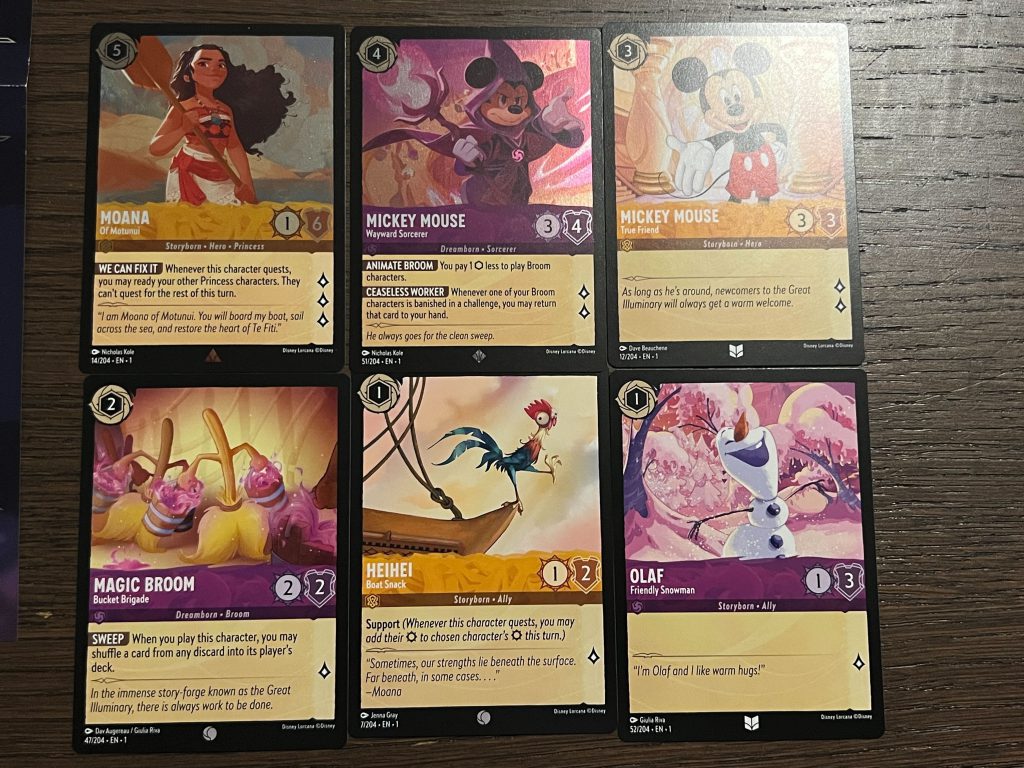
Navigation: Winning in Lorcana | Lorcana Cards Layout Explained | Everything You Need to Know About Lorcana Decks | Lorcana Match Set-Up | Lorcana Rules: Refresher Version | Lorcana Rules: In-Depth Version
Everything you need to know about Lorcana Decks
In order to play Disney Lorcana you’ll need at least 60 cards. The best way to do so is to pick up one of the Lorcana Starter Decks, which includes exactly the right number of cards, and each of those cards only belongs to either of two of the ink colours. This is important because each deck must only contain up-to two ink colours, so if you try and quickly build a deck with 5 boosters (which would give you 60 cards) then it’s incredibly rare that you’ll end up with enough cards to build a deck.
In addition to that, there are card limitations. You cannot have more than four of any one card in your deck — do note, that this is specific to the card, not to the character on the card.
The 60-card minimum means that you’ll need to build out a couple of different strategies in your deck, and if you have more in your deck (if there are 204 cards in Chapter 1, you could have up to 816 in your deck, after all) then you’ll need to strategise even more. Similarly, you could play with just one ink type in your deck, or you could just have characters in your deck — skipping out on items and songs.
A few tips for getting started with deck building.
- Play to your colour. Each colour is associated with a strategy: Steel hits hard, Sapphire is slow and strategic, Ruby hits fast but weak, Emerald is about thinking beyond the playing field, Amythest nerfs your opponent and Amber heals and buffs your deck.
- Always pack enough cards to fill your inkwell: If you don’t have enough characters, or abilities, to create a strong ink-well pile then you’ll eventually be outpaced by your rival.
- Build for a curve: The same can be said when adjusting your first hand, you should try to spread your card ink costs out, so that you have something to summon on each turn. If you didn’t put in any 3-ink cards, what happens on your third turn?
- Think about your hand when looking at abilities: If you’re putting a card in your inkwell and playing a character on every turn, but you are only drawing one card (by default) every turn then you’ll run out of cards very quickly. Make sure to include some characters and songs that let you rebuild your hand, or, if you’re feeling sinister, run down your rival’s.
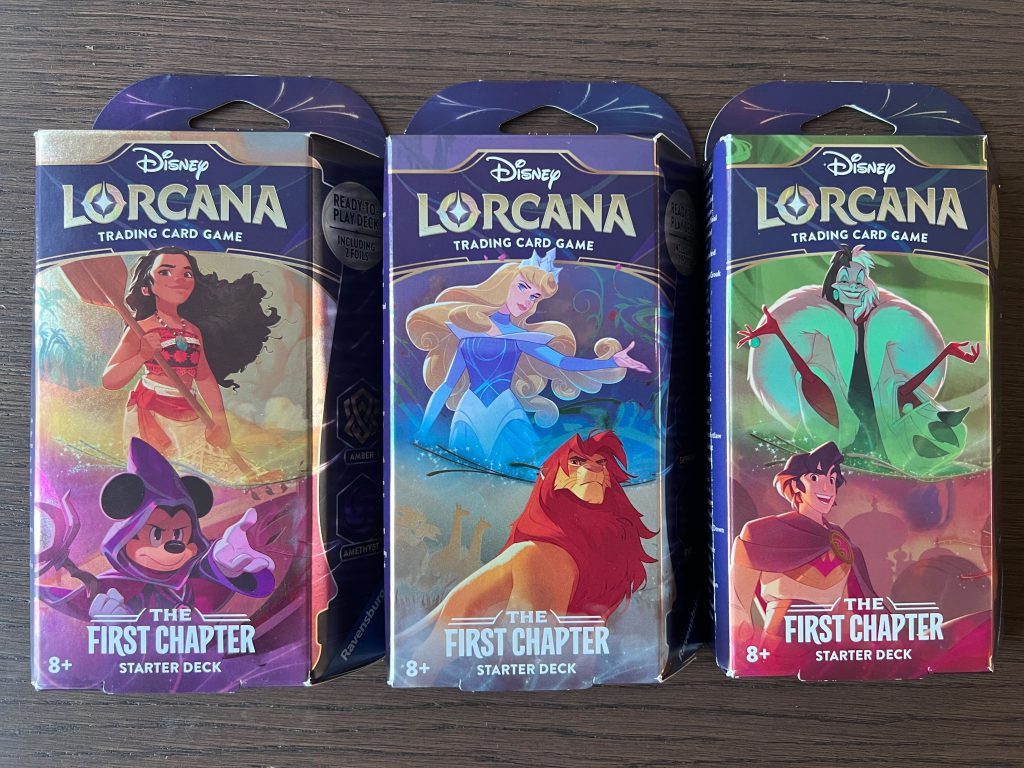
Navigation: Winning in Lorcana | Lorcana Cards Layout Explained | Everything You Need to Know About Lorcana Decks | Lorcana Match Set-Up | Lorcana Rules: Refresher Version | Lorcana Rules: In-Depth Version
Disney Lorcana Match Set-Up
Setting up for Lorcana is one of the easier experiences out there when it comes to CCGs, and that’s made even easier if you pick up one of the starter decks. That’s because these contain a tracker for your lore, as well as a few damage tokens.
Each player gathers their deck, sets up their lore tracker (to zero), and then shuffles their deck. After that, they then draw seven cards into their starting hand and decide who goes first.
At this point players, in play order, assess their hand and decide whether they want to mulligan any of the cards they have. They return their cards to the bottom of the deck (not showing them to the other players) and then draw back up to their starting hand of seven. It’s an important option to have, especially because you’ll want to craft a starting hand which allows for you to have a clear inking and summoning structure for your first few turns.
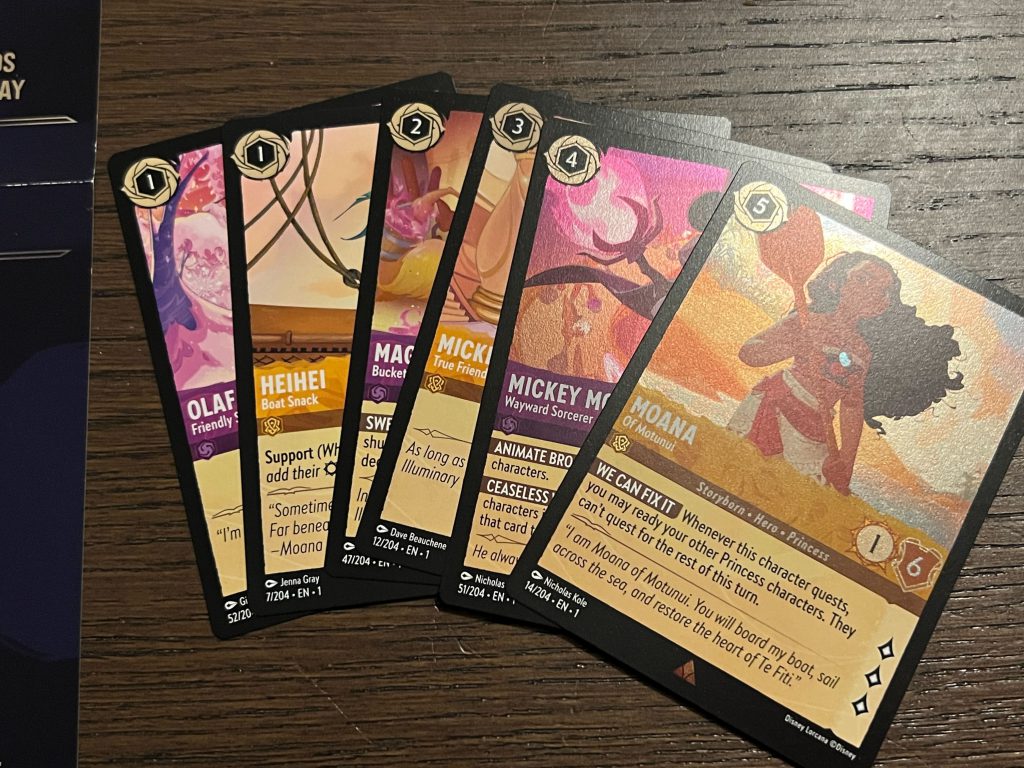
Navigation: Winning in Lorcana | Lorcana Cards Layout Explained | Everything You Need to Know About Lorcana Decks | Lorcana Match Set-Up | Lorcana Rules: Refresher Version | Lorcana Rules: In-Depth Version
Disney Lorcana Rules: Refresher Version
So, you’ve played a few matches of Lorcana, and you’ve pretty much got it down but then… oh no, your mind has gone blank. You’ve forgotten the fundamentals and need to blow off the dust and get going again. Don’t worry, we’ve all been there, and that’s why we’ve built this quickfire, easy-to-use Lorcana Rules Refresher for you.
On a turn: Begin with, Ready (remove exertion from cards, dry the ink on your summoned cards), Set (follow any abilities that mention Turn Start), Draw (your card and start your strategising). Note: The first player to play, doesn’t draw a new card on their first turn.
You can now: Place one card into your inkwell, spend ink on any abilities, exert any abilities, spend ink to summon characters or send characters to quest (instantly gaining lore). Note: If a character is summoned they are out of play (their ink is still drying) until the next turn unless rules state otherwise — you gain access to them in the Ready phase of the next turn. In addition to this, you can challenge an exerted rival character — which you resolve instantly, exerting your character and then having both characters deal simultaneous damage.

Don’t Forget:
- Songs can be summoned by spending ink, or by exerting a character who is of an appropriate ink level, they are then used instantly.
- Action cards are used instantly upon summoning, unlike item cards which are similar to characters but can not quest. Items can, however, be used immediately.
- If it helps, think of Items and Characters as similar (Game changing, multiple use), and Actions and Songs as similar (one-use, instant, discarded immediately after use). Items, of course, can’t quest and can be used immediately, while Songs can evade their raw ink cost with the exertion of a character.
- Play continues clockwise, regardless of how many players there are.
- You don’t always have to challenge, and you don’t always have to quest. You can only challenge an exerted character, regardless of how they were exerted.
Navigation: Winning in Lorcana | Lorcana Cards Layout Explained | Everything You Need to Know About Lorcana Decks | Lorcana Match Set-Up | Lorcana Rules: Refresher Version | Lorcana Rules: In-Depth Version
Disney Lorcana Rules: In-Depth Version
Okay, so, maybe you’ve lost the rulebook, or maybe you’re looking for a set of the Disney Lorcana rules that are in a most succinct, digestible format. That’s what this section is here for — to cover all of the bases and get you good to play from the second you’ve finished reading the rules.
Having completed the set-up you should have a deck of (at least) 60 cards in front of you, and five cards in your hand. You might have redrawn, you might not have, but either way, you’re ready to get started.
Each player takes a turn, with the play then rotating clockwise between players. The first player to go doesn’t draw a card to start, but otherwise — at all other turn starts — players will draw one card. Lorcana’s turns are split up into two different phases, which will be explained below after a quick explanation of the different card types in the game. Play will continue until a player wins by reaching 20 lore or being the last person with cards in their deck.
We’ll explain the different card types, then explain the two phases.
Different Lorcana Card Types Explained:
In Lorcana there are a couple of different card types that mostly follow the same rules, however have features that separate them from one another. Do read through the Lorcana Cards Layout Explained section to understand the different components of the cards (and the extra features that come with Character Cards), after that, pop back here and you’ll find the outline of the differences below.
Action Cards in Lorcana
Action cards are the easiest of the four card types in Lorcana to understand. Each one features a cost, its effects, its name, artwork and often very little more. You’ll expend ink equal to the cost in the top left corner during your turn and then resolve the text in the ability/effect area of the card. Once that’s done you’ll discard the card to your banished pile.
While action cards are the easiest of the cards, they can truly transform a play at short notice. Their one-shot nature underlines this.
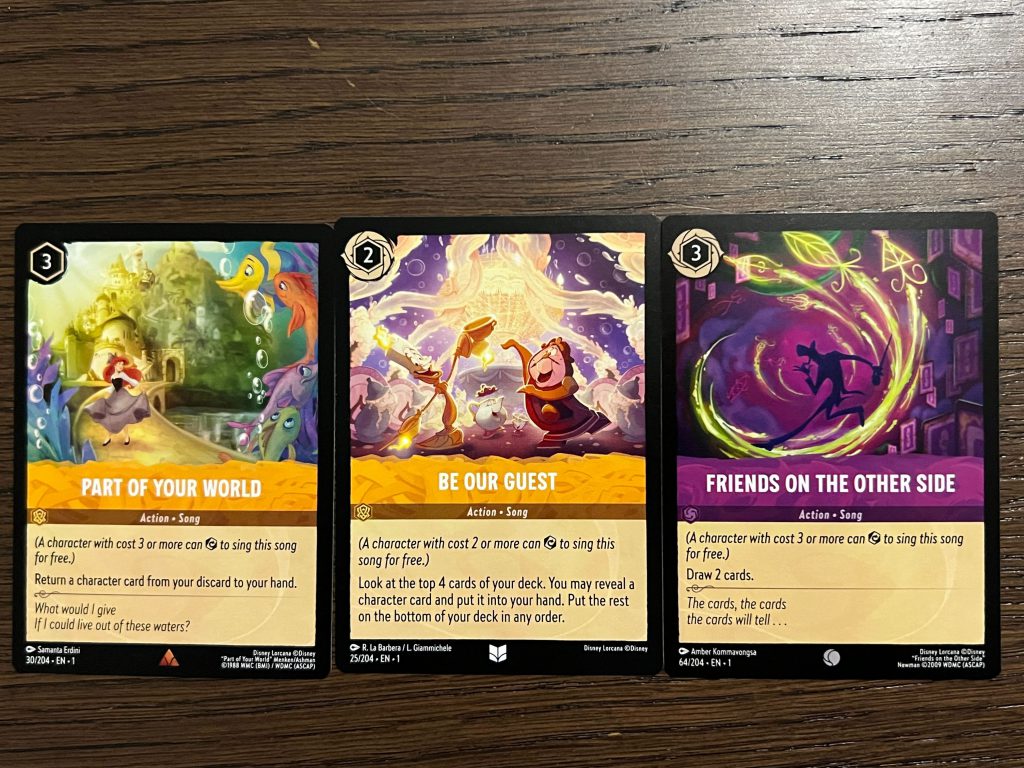
Song Cards in Lorcana
Next up are song cards. These are closest in nature to action cards, and are basically a subsection of them. The difference is that while they have an ink cost on them, there is also an extra block of text in the description area of the card which details that you can exert a character (turning them sideways and opening them to attack) of a minimum cost in order to play the song card for free.
Once this is done you discard the song card, just as you do with action cards.
If you’ve played a deck that features a lot of characters then song cards will always do well, as having a couple of exerted characters open to enemy attack, but still having a flush inkwell because the songs were played without cost is a strong place to be.

Item Cards in Lorcana
Item cards are the first type of card that we’ll discuss that persists. They feature all of the standard card components, including their ink cost and abilities, and that’s what you’ll mostly be referring to with them. Once an item glimmer is played it remains in your playing field even after it has been exerted, with the only way for your opponent to banish it being through using abilities or other action cards.
One advantage that items have over characters is that they can be used as soon as they are summoned, as they do not need the ‘ink to dry’ on them.
A steady flow of item cards can add wild combinations to your characters and build a solid ‘engine’ that powers up your play in the later stages of a magical duel.

Character Cards in Lorcana
Finally, there are character cards. These persist much like item cards, and also often feature abilities or effects, however, they also have strength and willpower statistics. This is very relevant because you need characters in order to win the game — the most common way to win is through accruing 20 lore.
Lore, symbolised by the weighted diamonds (present in the O of Lorcana), is gained by exerting the character. If exerted — be that through singing, questing, using one of their abilities or other reasons — in another player’s turn these characters can be challenged, requiring the challenger to exert their own card and then resulting in both characters simultaneously applying their strength to their rival’s willpower.
Character cards have some extra elements to them too: A character can have different variants (which means a character can ignore a deck card limit, but their forms can’t) which can shift between each other for a reduced fee. This is a great way to change a character’s abilities, but isn’t a fresh start as damage, item effects and exertion state persist.
Structure of a turn: Beginning Phase
At the start of a player’s turn, a player goes through the three steps: Ready, Set, Draw. These sign off any changes that have taken place since their last turn and get their cards and hands in order before they start making decisions during the main phase.
Ready: The player ‘dries the ink’ of any characters they summoned in their last turn, making them ready to use in the Main Phase. They also ready any exerted cards, which is done by turning them from side facing to upright. It’s essential you do this so you can track which cards are good to use during the main phase.
Set: At this point you’ll want to check any cards that you have in play to see if they have effects that mention the beginning phase and activate them.
Draw: Essential to filling your hand, as long as it’s not the very first player in the very first round you’ll now draw a card to your hand.

Structure of a turn: Main Phase
The main phase is the heart of a Disney Lorcana match, it’s here that you’ll be filling and using your inkwell, summoning glimmers, questing for lore and challenging your opponents.
The first thing that you’ll want to do, before anything else is add to your inkwell. You do this by taking a glimmer that has a circle around its ink cost, flipping it over and starting a pile of ink. You can commit one glimmer per turn in this way, and this is essential to winning as it’s the only way to be able to summon cards to the playfield. When you do this, you have to show your card to your opponent.
After doing that, there’s no particular order to spending the rest of your turn, and you can do them any number of times as long as you have the ink to spend, and cards out in the field are not exerted.
The actions that you can take are:
- Summoning a Glimmer: Playing a card from your hand by spending ink from your inkwell.
- Using an Ability: If you have a character in play that isn’t exerted, or you play an item, you can then play the ability on the card for any cost detailed on it.
- Quest: This is done by exerting a character card that has lore markers on them, and you instantly bank the amount of lore icons on it.
- Challenge: If your opponent has an exerted character card (from questing, using abilities, or other effects) then you can challenge them by exerting your characters on your turn. At this point both characters deal and take willpower damage.
Once you’re done with your above actions you signal that it is the end of your turn, and play continues clockwise.
With that, you should be fully ready to play your next game of Disney Lorcana. If you’ve any questions, or there’s something we’ve missed then feel free to comment below and we’ll add to this guide.
Comments are closed.